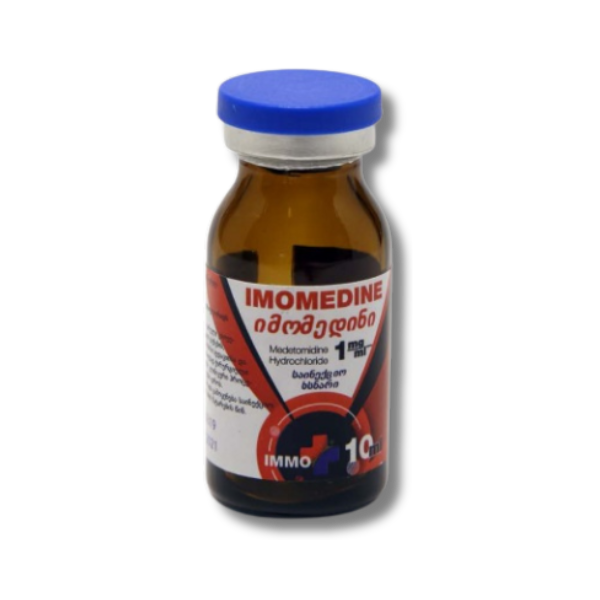Imomedine
Imomedin 0.1% (Imomedin 0.1%)
International Nonproprietary Name: Medetomidine Hydrochloride
Manufacturer: LLC "Biotecsi"
Country of Origin: Georgia
Dosage form: Injectable solution
Pharmacotherapeutic group: Sedative and analgesic
Target species: Wild animals, ruminants, pigs, horses, dogs, cats
Composition:
Colorless, transparent injectable solution.
1 ml contains:
Active substance:
Medetomidine Hydrochloride – 1.0 mg (0.1%)
Excipients:
-
Benzyl alcohol
-
Sodium chloride
-
Water for injection
Packaging:
The product is packaged in 10 ml glass vials sealed with a chlorobutyl rubber stopper with inert coating, an aluminum cap, and a polypropylene flip-off seal.
Pharmacological properties
The drug belongs to the group of α2-adrenergic receptor agonists. The active substance, medetomidine hydrochloride, is an α2-adrenergic receptor stimulator that acts by inhibiting the transmission of nerve impulses due to competitive interaction with norepinephrine. It causes depression of the central nervous system and increases the pain threshold.
The effect of Imomedin depends on the dose:
-
Low doses → moderate sedation without analgesia
-
High doses → significant sedative and analgesic effect
Intravenous injection results in rapid onset of action, while intramuscular and subcutaneous injections act more slowly.
After intramuscular injection, the maximum blood concentration is reached in 15–30 minutes. The drug is quickly absorbed and distributed in the body, binding to serum proteins at 85–90%. It is oxidized in the liver and partially methylated in the kidneys. Most metabolites are excreted with urine.
Half-life: 1–2 hours.
According to GOST 12.1.007, the drug belongs to moderately hazardous substances (hazard class III). When used in recommended doses, it is well tolerated, with no pronounced embryotoxic, teratogenic, or hepatotoxic effects.
Indications for use
The drug is used in wild animals, ruminants, pigs, horses, dogs, and cats to achieve sedation and analgesia during surgical operations, painful clinical procedures, and examinations. Recommended for use prior to injectable and/or inhalation anesthesia.
Contraindications
Do not use:
-
During pregnancy and lactation
-
In animals in shock, weakened, or debilitated
-
In case of hypersensitivity to the drug components
-
In animals with severe cardiovascular or respiratory diseases, liver or kidney dysfunction, gastrointestinal injuries (gastric torsion, organ entrapment, esophageal obstruction), diabetes mellitus, or increased intraocular pressure
Dosage and administration
Administer parenterally, single dose:
-
Dogs and cats: IV, IM, or SC
-
Horses: IV
-
Wild and ruminant animals: IM
If necessary, a second injection can be administered 10–15 minutes after the first dose.
For sedation and analgesia:
-
Horses: Imomedin 0.1%, IV at a dose of 0.2–1.2 ml per 100 kg
-
Dogs: Imomedin 0.1% – 0.1–0.8 ml per 10 kg
-
Cats: Imomedin 0.1% – 0.015–0.15 ml per kg
Doses vary depending on the desired effect and the animal's individual characteristics and breed. Small dog breeds require relatively higher doses than large breeds.
For horses, the drug should be administered intravenously, very slowly (1 ml per minute). Use two sterile needles: one for filling the syringe from the vial and the other for injecting the animal.
Side effects
-
In cats (most cases) and about 10% of dogs: vomiting after administration and during recovery
-
Food intake should be discontinued 12 hours before anesthesia
-
Animals should be kept warm before and during anesthesia
In horses:
-
Temporary arrhythmia
-
Incoordination
-
Sweating
-
Occasional mild muscle tremors and involuntary urination
-
Blood pressure initially rises slightly, then returns to baseline or falls below it
Drug interactions
Best results are obtained when combined with ketamine or butorphanol.
Do not combine with sympathomimetic amines or trimethoprim-sulfonamide combinations.
When combined with drugs that depress the CNS, the sedative effect of Imomedin may increase; in such cases, dosage should be adjusted.
Overdose
Signs: apnea, bradycardia, hypotension
If overdose threatens life or sedation needs to be reversed: administer atipamezole in an appropriate dose.
Bradycardia can be treated with atropine while maintaining sedation.
Personal safety
Follow general personal hygiene and safety rules. Wash hands thoroughly after handling the drug.
If the drug contacts skin or mucous membranes, rinse immediately with plenty of water.
People with hypersensitivity should avoid direct contact.
In case of accidental ingestion or allergic reaction, seek medical attention (bring instructions or label).
Storage conditions
Store at 15–25°C, in original packaging, in a dry, dark place, away from food and feed.
Keep out of reach of children. Do not freeze.
Shelf life: 3 years. After opening, use within 28 days.
Do not use after the expiration date. Dispose of expired product according to regulations.
Manufacturer’s address: Georgia, Tbilisi, Iumashvili St. #8

